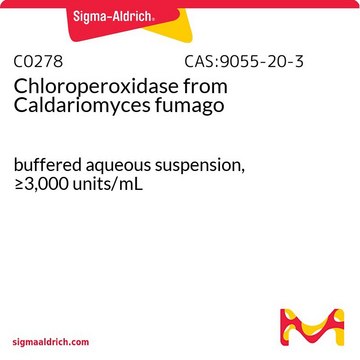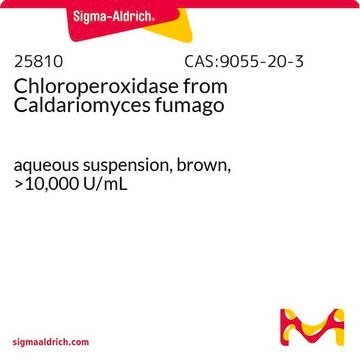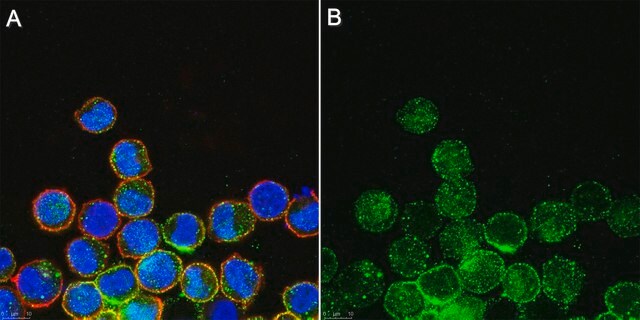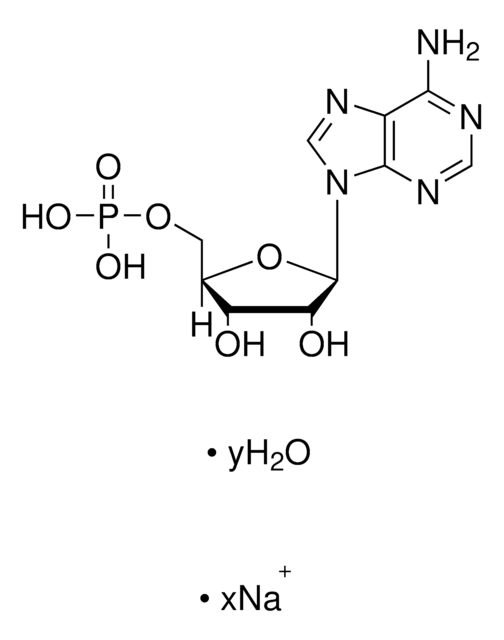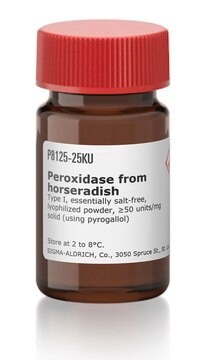C0887
Chloroperoxidase from Caldariomyces fumago
buffered aqueous suspension, 1,000-2,000 units/mg protein (E1%/280)
Synonym(s):
Chloride Peroxidase, Chloride:hydrogen-peroxide oxidoreductase
Sign Into View Organizational & Contract Pricing
All Photos(1)
About This Item
CAS Number:
MDL number:
UNSPSC Code:
12352204
NACRES:
NA.54
Recommended Products
biological source
fungus (Caldariomyces fumago)
Quality Level
form
buffered aqueous suspension
specific activity
1,000-2,000 units/mg protein (E1%/280)
mol wt
42 kDa
absorbance ratio
RZ ~1.0
storage temp.
2-8°C
Looking for similar products? Visit Product Comparison Guide
Application
A useful alternative to lactoperoxidase for 131I ion labeling studies, for bromination of proteins, and for 36Cl labeling of macromolecules in long-term isolation procedures.
Biochem/physiol Actions
Chloroperoxidase (CPO) is a 42,000 Da extracellular heme glycoenzyme containing ferriprotoporphyrin IX as the prosthetic group. CPO is secreted from fungus and exhibits a broad spectrum of chemical reactivities. It is a peroxide-dependent chlorinating enzyme. It also catalyzes peroxidase-, catalase- and cytochrome P450-type reactions of dehydrogenation, H2O2 decomposition and oxygen insertion, respectively. The enzyme has magnetic and spectroscopic properties similar to that of cyctochrome P-450. CPO from the fungus Caldariomyces fumago has the capacity to chlorinate aromatic hydrocarbons, including polycyclic aromatic hydrocarbons (PAHs).
Unit Definition
One unit will catalyze the conversion of 1.0 μmole of monochlorodimedon to dichlorodimedon per min at pH 2.75 at 25 °C in the presence of potassium chloride and H2O2.
Physical form
Purified suspension in 0.1 M sodium phosphate solution, pH approx. 4.5
Inhibitor
Product No.
Description
Pricing
Storage Class
12 - Non Combustible Liquids
wgk_germany
WGK 1
flash_point_f
Not applicable
flash_point_c
Not applicable
ppe
Eyeshields, Gloves, multi-purpose combination respirator cartridge (US)
Choose from one of the most recent versions:
Already Own This Product?
Find documentation for the products that you have recently purchased in the Document Library.
René Ullrich et al.
Applied and environmental microbiology, 70(8), 4575-4581 (2004-08-06)
Agrocybe aegerita, a bark mulch- and wood-colonizing basidiomycete, was found to produce a peroxidase (AaP) that oxidizes aryl alcohols, such as veratryl and benzyl alcohols, into the corresponding aldehydes and then into benzoic acids. The enzyme also catalyzed the oxidation
R Vázquez-Duhalt et al.
Phytochemistry, 58(6), 929-933 (2001-10-31)
Chloroperoxidase from Caldariomyces fumago was able to chlorinate 17 of 20 aromatic hydrocarbons assayed in the presence of hydrogen peroxide and chloride ions. Reaction rates varied from 0.6 min(-1) for naphthalene to 758 min(-1) for 9-methylanthracene. Mono-, di- and tri-chlorinated
Chaonan Li et al.
Applied biochemistry and biotechnology, 165(7-8), 1691-1707 (2011-09-29)
Chloroperoxidase (CPO) is thought to be the most versatile heme-containing enzyme with enormous applications in organic synthesis, biotransformation, pharmaceutical production, and detoxification of environmental pollutants. Any improvement in the stability of this enzyme will greatly enhance its application in the
Kelath Murali Manoj et al.
PloS one, 5(5), e10601-e10601 (2010-05-26)
Many heme enzymes show remarkable versatility and atypical kinetics. The fungal extracellular enzyme chloroperoxidase (CPO) characterizes a variety of one and two electron redox reactions in the presence of hydroperoxides. A structural counterpart, found in mammalian microsomal cytochrome P450 (CYP)
Rabindra Kumar Behera et al.
Journal of inorganic biochemistry, 104(11), 1185-1194 (2010-08-17)
The site specific mutants of the thermophilic P450 (P450 175A1 or CYP175A1) were designed to introduce residues that could act as acid-base catalysts near the active site to enhance the peroxidases activity. The Leu80 in the distal heme pocket of
Our team of scientists has experience in all areas of research including Life Science, Material Science, Chemical Synthesis, Chromatography, Analytical and many others.
Contact Technical Service